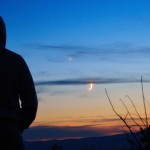
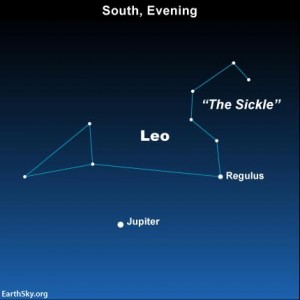
Jupiter is in the eastern half of sky at nightfall and reaches its high point for the night at mid-to-late evening.

Will you catch the young moon with Mercury after sunset April 8? Maybe! Read more.
The king of planets – Jupiter – is the brightest starlike object in the April, 2016, night sky. It pops out first thing at dusk and lights up the nighttime until the wee hours of the morning. At mid-northern latitudes, Mars and Saturn rise over the eastern horizon at mid-to-late evening (and in the Southern Hemisphere, at early-to-mid evening). Once these two planets are up, they are out for rest of the night, near each other, getting brighter, heading toward their brightest and best in late May and early June. Mars and Saturn join up with the bright star Antares to form a bright celestial triangle, which is especially prominent during the predawn hours. Mercury puts on a good show in the Northern Hemisphere evening sky, later this month. The brightest planet – Venus – is lost in the glare of sunrise. Follow the links below to learn more about the April planets.
Jupiter brightest “star” on April nights
Mars, late evening until dawn, gets much brighter!
Saturn shines near Mars from late evening until dawn
Mercury’s best evening apparition for N. Hemisphere
Venus, brightest planet, lost in the sunrise
Like what EarthSky offers? Sign up for our free daily newsletter today!
Astronomy events, star parties, festivals, workshops
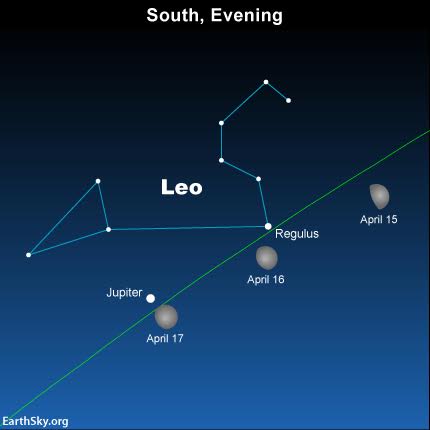
Use the moon to find the the planet Jupiter and the star Regulus on April 15, 16 and 17. The green line depicts the ecliptic – Earth’s orbital plane projected onto the constellations of the Zodiac. Read more.
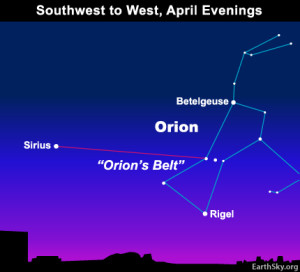
Sirius, the brightest star of nighttime, predominates over the western half of sky at nightfall. Orion’s Belt points to Sirius, not Jupiter! Read more.
Jupiter brightest “star” on April nights. Jupiter is the only planet to light up the sky almost immediately after sunset. You’ll easily spot it blazing away in the eastern half of sky at nightfall.
This giant planet climbs highest up for the night at roughly 9 to 10 p.m. local time (10 to 11 p.m. local daylight-saving time) and sets in the west before dawn. Jupiter will remain a fine evening prospect for months to come.
Although Jupiter is almost impossible to miss, it might be possible to confuse it with Sirius, the brightest star in the night sky. At nightfall and early evening, Jupiter lords over the eastern half of sky, while Sirius shines way to the west of Jupiter, dominating over the western half of sky. From either the Northern or Southern Hemisphere, you can rely on the famous constellation Orion the Hunter to confirm that you’re looking at Sirius, and not Jupiter, because Orion’s Belt of three stars points right to this sparkling blue-white star.
The moon swings close to Jupiter on the sky’s dome for several days, centered on April 17.
If you have binoculars or a telescope, it’s fairly easy to see Jupiter’s four major moons, which look like pinpricks of light on or near the same plane. They are often called the Galilean moons to honor Galileo, who discovered these great Jovian moons in 1610. In their order from Jupiter, these moons are Io, Europa, Ganymede and Callisto.
These moons circle Jupiter around the Jovian equator. In cycles of six years, we view Jupiter’s equator edge-on. So, in 2015, we got to view a number of mutual events involving Jupiter’s moons through a high-powered telescope. Click here or here or here for more details.
Although Jupiter’s axial tilt is only 3o out of perpendicular relative to the ecliptic (Earth’s orbital plane), Jupiter’s axis will tilt enough toward the sun and Earth so that the farthest of these four moons, Callisto, will NOT pass in front of Jupiter or behind Jupiter for a period of about three years, starting in late 2016. During this approximate 3-year period, Callisto will remain “perpetually” visible, alternately swinging “above” and “below” Jupiter.
Click here for a Jupiter’s moons almanac, courtesy of Sky & Telescope.

The moon swings by Mars, Saturn and Antares on April 24, 25 and 26. The green line depicts the ecliptic. Read more.
Mars, late evening until dawn, gets much brighter! Mars is not as bright as Jupiter, April’s most brilliant starlike object. However, Jupiter will dim slightly this month, while Mars will double in brilliance in April 2016 alone!
By the time Mars reaches its crest of brightness in late May 2016, it will have quadrupled in brilliance since the beginning of April. So watch Mars, which has greater swings in brilliance than any other solar system planet, except for Mercury.
At is brightest, Mars shines some 80 times more brilliantly than at its faintest.
Why is Mars getting so bright? For most of the past two years, Earth has been fleeing ahead of Mars in orbit. Mars orbits just one step outward from us, and we move slightly faster in orbit, and – about every two years – we catch up to Mars again and pass between it and the sun. That’ll happen next in late May, 2016. Astronomers will say that Mars is in opposition to the sun around that time. Then, believe it or not, Mars will nearly match Jupiter in brightness!
By late May, as we pass between it and the sun, Mars will be rising in the east as the sun is setting in the west. It’ll be opposite the sun, in opposition.
In April, though, Mars rises in the east quite late at night, as seen from mid-northern latitudes and is still perhaps best seen in the hours before dawn. Mars rises around 11 p.m. local time (midnight, if you use Daylight Time) in early April. By the end of the month, Mars rises at about 9 p.m. local time (10 p.m. Daylight Time) at mid-northern latitudes.
Mars rises earlier at temperate latitudes in the Southern Hemisphere. In early April, the red planet comes up around 9 to 10 p.m. in early March, and by the month’s end, around nightfall.
Looking for a sky almanac? EarthSky recommends…
And here’s the really good news. Mars is near another planet on the sky’s dome, Saturn. Look for Mars and Saturn to be highest up in the sky just before dawn’s first light.
Let the waning gibbous moon help guide your eye to Mars (and Saturn) in the morning sky for several days, centered on April 25 (or catch the moon, Mars and Saturn low in the southeast sky late at night).
Saturn shines near Mars from late evening until dawn. And both Mars and Saturn are near a fainter object – still one of the sky’s brightest stars – Antares in the constellation Scorpius.
From mid-northern latitudes, the ringed planet starts the month rising in the east somewhat before midnight local time (1 a.m. Daylight Time), and by the month’s end, coming up around 10 p.m. local time (11 p.m. Daylight Time).
As for temperate latitudes in the Southern Hemisphere, Saturn rises in the east at roughly 10 p.m. local time in early April. By the end of the month, Saturn will be up by around 8 p.m. local time.
Although Saturn shines on par with the sky’s brightest stars, its brilliance can’t match that of Mars. Look for Saturn near Mars at late evening or in the predawn sky. These two worlds form a bright celestial triangle with the star Antares in the April predawn sky. Mars is brighter than Saturn, which in turn is brighter than Antares.
Mars will eventually catch up with Saturn on August 24, 2016, to present a conjunction of these two worlds in the August evening sky.
Watch for the moon to swing by Saturn for several days, centered on or near April 25. Scroll up to the second sky chart above.
Saturn, the farthest world that you can easily view with the eye alone, appears golden in color. It shines with a steady light. Binoculars don’t reveal Saturn’s gorgeous rings, by the way. For that, you need a small telescope. But binoculars will enhance Saturn’s golden color.
Saturn’s rings are inclined at a little more than 26o from edge-on in April 2016, exhibiting their northern face. Next year, in October 2017, the rings will open most widely, displaying a maximum inclination of 27o. As with so much in space (and on Earth), the appearance of Saturn’s rings from Earth is cyclical. In the year 2025, the rings will appear edge-on as seen from Earth. After that, we’ll begin to see the south side of Saturn’s rings, to increase to a maximum inclination of 27o by May, 2032.
Click here for recommended almanacs. They can help you know when the planets rise, transit and set in your sky

At northerly latitudes, we have a good chance of catching the young moon with Mercury after sunset April 8. Read more.
Mercury’s best evening apparition for N. Hemisphere. Mercury sets after the sun all month long in April 2016. In the Northern hemisphere and the southern tropics, Mercury will probably climb far enough from the sunset glare to become visible in the evening twilight by the end of the first week of April. After that, at northerly latitudes, Mercury should remain in relatively good view at nightfall for a couple more weeks.
For the Northern Hemisphere, April 2016 presents the best apparition of Mercury in the evening sky for the entire year.
Try you luck catching the young waxing crescent moon and Mercury after sunset, starting on April 8. Mercury will swing to its greatest elongation – farthest angular distance from the sun – some ten days later, on April 18. For several days, centered on April 18, Mercury will actually stay out until nightfall. Find an unobstructed horizon in the direction of sunset and bring binoculars, if you have them.
Temperate latitudes in the Southern Hemisphere have little to no chance of catching Mercury in April, but southerly latitudes will get their chance to see Mercury in the morning sky in late May and June, 2016.
The planet Mercury in its orbit will swing directly in between the Earth and sun, as it transitions from the evening to the morning sky, on May 9, 2016, to showcase the first transit of Mercury since November 8, 2006.
Venus, brightest planet, lost in the sunrise. From all over the world, Venus sinks closer to the glare of sunrise all month long. From the Southern Hemisphere, you might be able to glimpse Venus before sunrise in the early part of April. From northerly latitudes, Venus will be extremely hard to catch this month. Venus will pass directly behind the sun on June 6, 2016, as it transitions from the morning to the evening sky.
Exactly four years previous to Venus passing directly behind the sun on June 6, 2016, Venus swung directly in front of the sun on June 6, 2012, to present the last transit of Venus until December 11, 2117. See the photo above.
What do we mean by bright planet? By bright planet, we mean any solar system planet that is easily visible without an optical aid and that has been watched by our ancestors since time immemorial. In their outward order from the sun, the five bright planets are Mercury, Venus, Mars, Jupiter and Saturn. These planets actually do appear bright in our sky. They are typically as bright as – or brighter than – the brightest stars. Plus, these relatively nearby worlds tend to shine with a steadier light than the distant, twinkling stars. You can spot them, and come to know them as faithful friends, if you try.
Bottom line: April 2016 is still Jupiter’s month to bask in the light of the sun. But two other planets, Mars and Saturn, are in fine view in the predawn hours, and with some diligence, you might catch Mercury after sunset.
Easily locate stars and constellations with EarthSky’s planisphere.
Don’t miss anything. Subscribe to EarthSky News by email
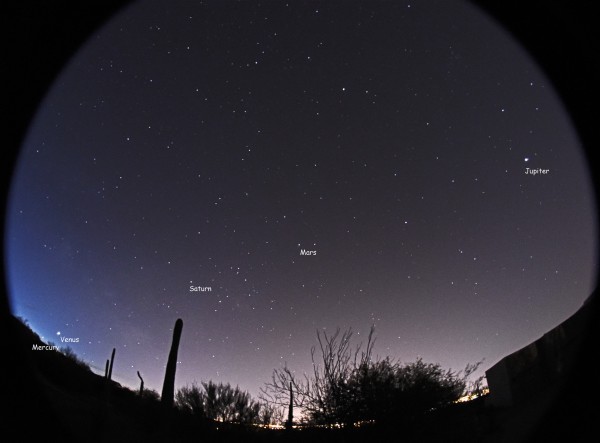
From late January, and through mid-February, 5 bright planets were visible at once in the predawn sky. This image is from February 8, 2016. It’s by Eliot Herman in Tucson, Arizona. View on Flickr.
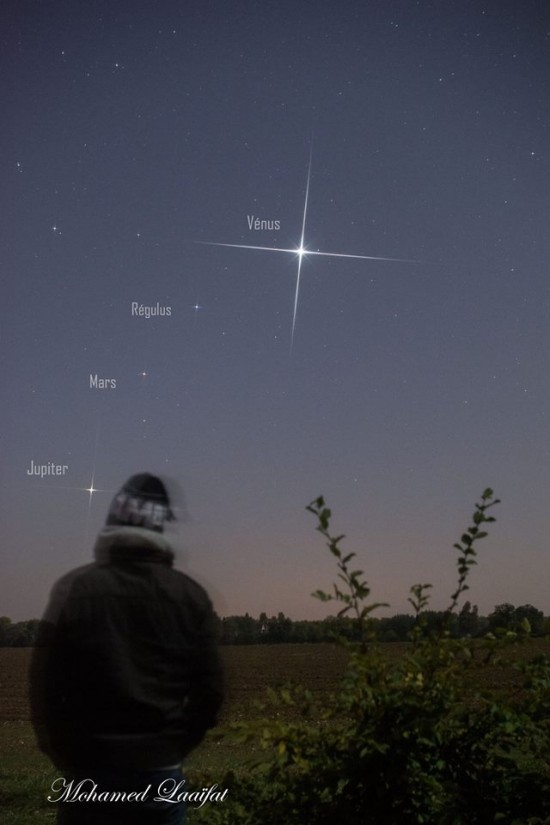
Awesome month for planets before dawn: October, 2015! Photo taken October 2, 2015 by Mohamed Laaifat Photographies in Normandy, France.
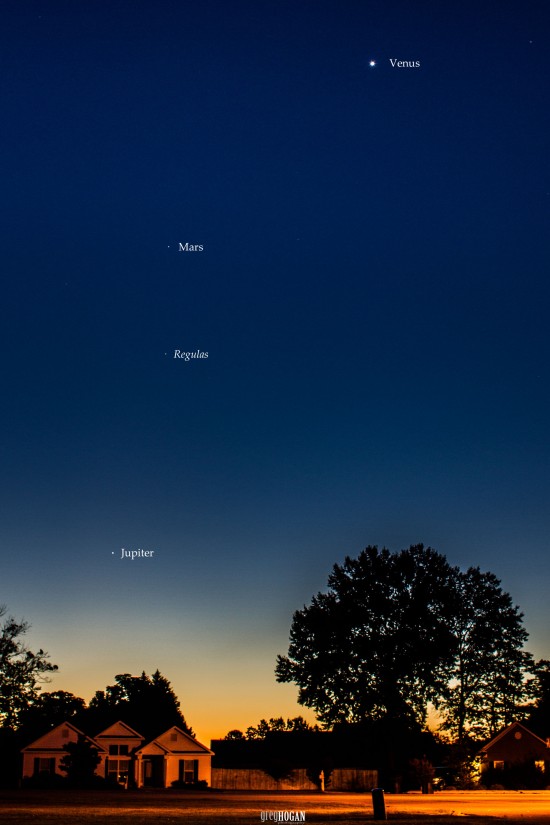
Eastern sky before dawn now. Photo taken September 18, 2015 and submitted to EarthSky by Greg Hogan in Kathleen, Georgia. Thanks, Greg!
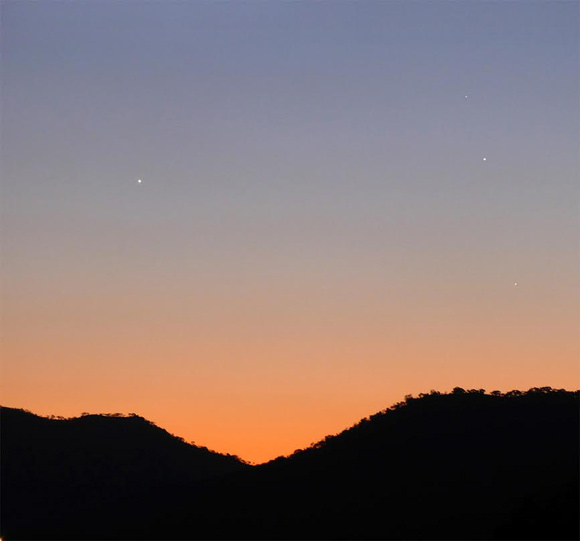
View larger. Evening dusk on August 5: Venus at left. Mercury is climbing higher, toward Regulus (at top) and Jupiter (beneath Regulus).

By the evening of July 12, Venus and Jupiter were farther apart and lower in the western sky after sunset. Photo by Robert Kelly. Thanks, Robert!
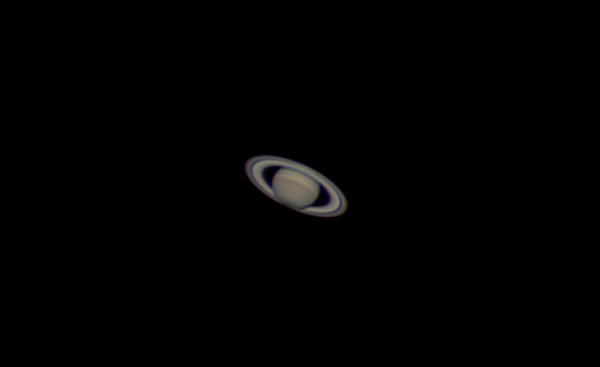
Photo taken June 13, 2015 by John Nelson at Puget Sound, Washington. Thanks, John!
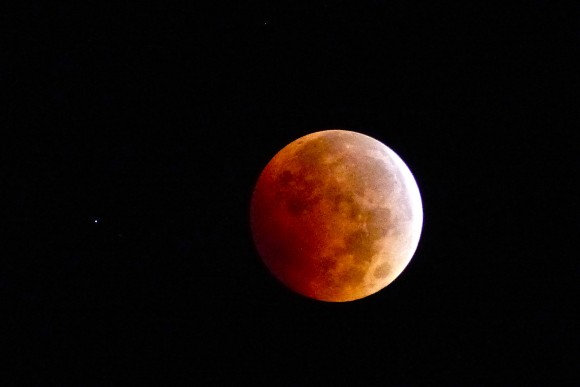
Lunar eclipse on the night of October 8, 2014. The object to the left is the planet Uranus! This beautiful photo is by Janey Wing Kenyon of Story, Wyoming.
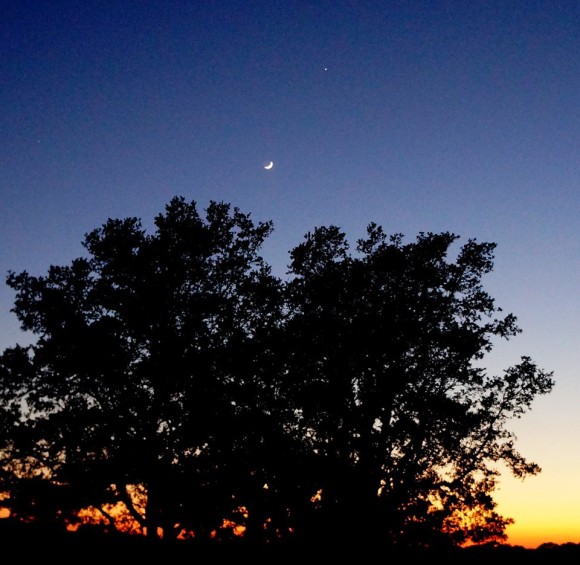
Debra Fryar in Calobreves, Texas captured this photo of the moon and Jupiter on May 31, 2014. Jupiter was close to the twilight then.
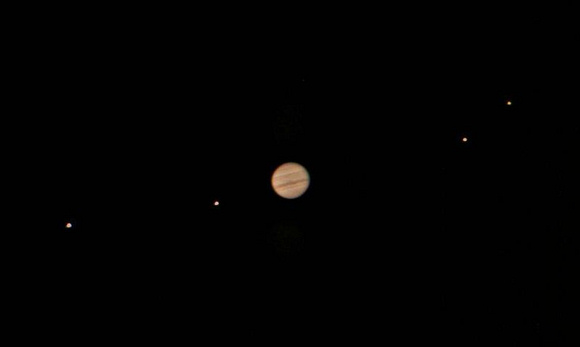
With only a modest backyard telescope, you can easily see Jupiter’s four largest moons. Here they are through a 10″ (25 cm) Meade LX200 telescope. Image credit: Jan Sandberg
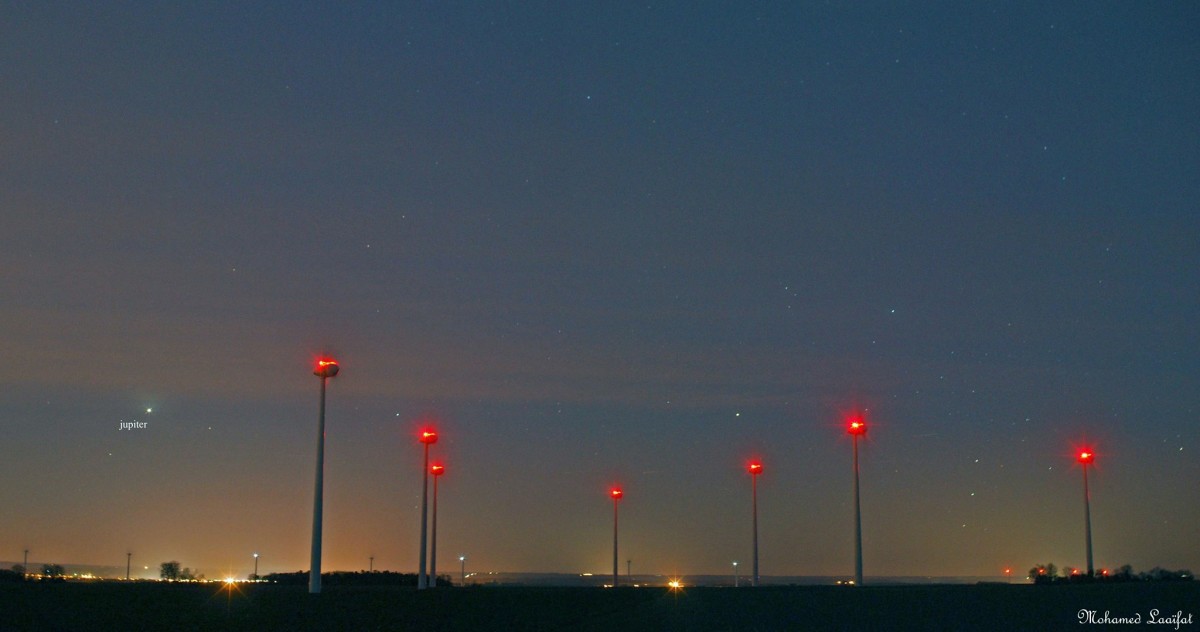
Jupiter was rivaling the streetlights, when Mohamed Laaifat Photographies captured this photo in Normandy, France. Visit his page on Facebook.

Venus by Danny Crocker-Jensen
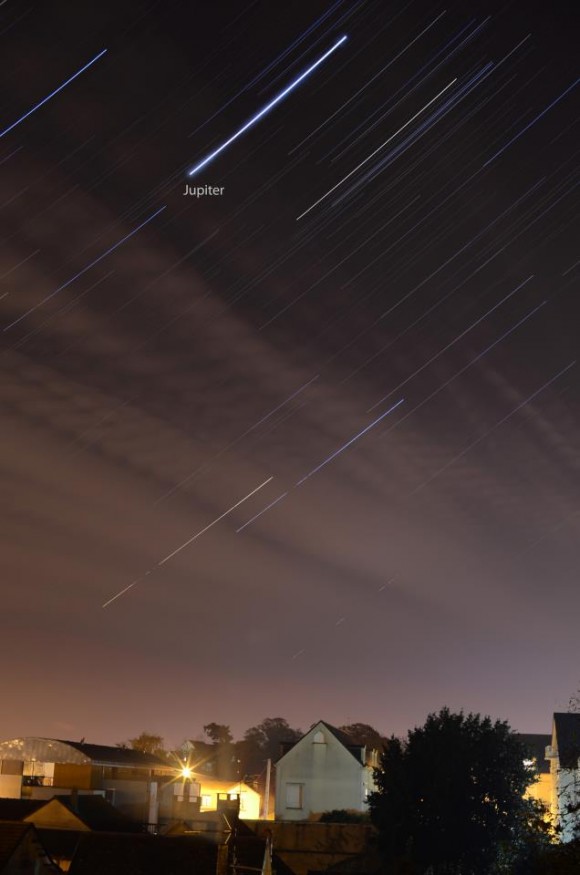
These are called star trails. It’s a long-exposure photo, which shows you how Earth is turning under the stars. The brightest object here is Jupiter, which is the second-brightest planet, after Venus. This awesome photo by EarthSky Facebook friend Mohamed Laaifat in Normandy, France. Thank you, Mohamed.

Skywatcher, by Predrag Agatonovic.
Easily locate stars and constellations with EarthSky’s planisphere.
Don’t miss anything. Subscribe to EarthSky News by email
from EarthSky http://ift.tt/IJfHCr


Jupiter is in the eastern half of sky at nightfall and reaches its high point for the night at mid-to-late evening.

Will you catch the young moon with Mercury after sunset April 8? Maybe! Read more.
The king of planets – Jupiter – is the brightest starlike object in the April, 2016, night sky. It pops out first thing at dusk and lights up the nighttime until the wee hours of the morning. At mid-northern latitudes, Mars and Saturn rise over the eastern horizon at mid-to-late evening (and in the Southern Hemisphere, at early-to-mid evening). Once these two planets are up, they are out for rest of the night, near each other, getting brighter, heading toward their brightest and best in late May and early June. Mars and Saturn join up with the bright star Antares to form a bright celestial triangle, which is especially prominent during the predawn hours. Mercury puts on a good show in the Northern Hemisphere evening sky, later this month. The brightest planet – Venus – is lost in the glare of sunrise. Follow the links below to learn more about the April planets.
Jupiter brightest “star” on April nights
Mars, late evening until dawn, gets much brighter!
Saturn shines near Mars from late evening until dawn
Mercury’s best evening apparition for N. Hemisphere
Venus, brightest planet, lost in the sunrise
Like what EarthSky offers? Sign up for our free daily newsletter today!
Astronomy events, star parties, festivals, workshops

Use the moon to find the the planet Jupiter and the star Regulus on April 15, 16 and 17. The green line depicts the ecliptic – Earth’s orbital plane projected onto the constellations of the Zodiac. Read more.

Sirius, the brightest star of nighttime, predominates over the western half of sky at nightfall. Orion’s Belt points to Sirius, not Jupiter! Read more.
Jupiter brightest “star” on April nights. Jupiter is the only planet to light up the sky almost immediately after sunset. You’ll easily spot it blazing away in the eastern half of sky at nightfall.
This giant planet climbs highest up for the night at roughly 9 to 10 p.m. local time (10 to 11 p.m. local daylight-saving time) and sets in the west before dawn. Jupiter will remain a fine evening prospect for months to come.
Although Jupiter is almost impossible to miss, it might be possible to confuse it with Sirius, the brightest star in the night sky. At nightfall and early evening, Jupiter lords over the eastern half of sky, while Sirius shines way to the west of Jupiter, dominating over the western half of sky. From either the Northern or Southern Hemisphere, you can rely on the famous constellation Orion the Hunter to confirm that you’re looking at Sirius, and not Jupiter, because Orion’s Belt of three stars points right to this sparkling blue-white star.
The moon swings close to Jupiter on the sky’s dome for several days, centered on April 17.
If you have binoculars or a telescope, it’s fairly easy to see Jupiter’s four major moons, which look like pinpricks of light on or near the same plane. They are often called the Galilean moons to honor Galileo, who discovered these great Jovian moons in 1610. In their order from Jupiter, these moons are Io, Europa, Ganymede and Callisto.
These moons circle Jupiter around the Jovian equator. In cycles of six years, we view Jupiter’s equator edge-on. So, in 2015, we got to view a number of mutual events involving Jupiter’s moons through a high-powered telescope. Click here or here or here for more details.
Although Jupiter’s axial tilt is only 3o out of perpendicular relative to the ecliptic (Earth’s orbital plane), Jupiter’s axis will tilt enough toward the sun and Earth so that the farthest of these four moons, Callisto, will NOT pass in front of Jupiter or behind Jupiter for a period of about three years, starting in late 2016. During this approximate 3-year period, Callisto will remain “perpetually” visible, alternately swinging “above” and “below” Jupiter.
Click here for a Jupiter’s moons almanac, courtesy of Sky & Telescope.

The moon swings by Mars, Saturn and Antares on April 24, 25 and 26. The green line depicts the ecliptic. Read more.
Mars, late evening until dawn, gets much brighter! Mars is not as bright as Jupiter, April’s most brilliant starlike object. However, Jupiter will dim slightly this month, while Mars will double in brilliance in April 2016 alone!
By the time Mars reaches its crest of brightness in late May 2016, it will have quadrupled in brilliance since the beginning of April. So watch Mars, which has greater swings in brilliance than any other solar system planet, except for Mercury.
At is brightest, Mars shines some 80 times more brilliantly than at its faintest.
Why is Mars getting so bright? For most of the past two years, Earth has been fleeing ahead of Mars in orbit. Mars orbits just one step outward from us, and we move slightly faster in orbit, and – about every two years – we catch up to Mars again and pass between it and the sun. That’ll happen next in late May, 2016. Astronomers will say that Mars is in opposition to the sun around that time. Then, believe it or not, Mars will nearly match Jupiter in brightness!
By late May, as we pass between it and the sun, Mars will be rising in the east as the sun is setting in the west. It’ll be opposite the sun, in opposition.
In April, though, Mars rises in the east quite late at night, as seen from mid-northern latitudes and is still perhaps best seen in the hours before dawn. Mars rises around 11 p.m. local time (midnight, if you use Daylight Time) in early April. By the end of the month, Mars rises at about 9 p.m. local time (10 p.m. Daylight Time) at mid-northern latitudes.
Mars rises earlier at temperate latitudes in the Southern Hemisphere. In early April, the red planet comes up around 9 to 10 p.m. in early March, and by the month’s end, around nightfall.
Looking for a sky almanac? EarthSky recommends…
And here’s the really good news. Mars is near another planet on the sky’s dome, Saturn. Look for Mars and Saturn to be highest up in the sky just before dawn’s first light.
Let the waning gibbous moon help guide your eye to Mars (and Saturn) in the morning sky for several days, centered on April 25 (or catch the moon, Mars and Saturn low in the southeast sky late at night).
Saturn shines near Mars from late evening until dawn. And both Mars and Saturn are near a fainter object – still one of the sky’s brightest stars – Antares in the constellation Scorpius.
From mid-northern latitudes, the ringed planet starts the month rising in the east somewhat before midnight local time (1 a.m. Daylight Time), and by the month’s end, coming up around 10 p.m. local time (11 p.m. Daylight Time).
As for temperate latitudes in the Southern Hemisphere, Saturn rises in the east at roughly 10 p.m. local time in early April. By the end of the month, Saturn will be up by around 8 p.m. local time.
Although Saturn shines on par with the sky’s brightest stars, its brilliance can’t match that of Mars. Look for Saturn near Mars at late evening or in the predawn sky. These two worlds form a bright celestial triangle with the star Antares in the April predawn sky. Mars is brighter than Saturn, which in turn is brighter than Antares.
Mars will eventually catch up with Saturn on August 24, 2016, to present a conjunction of these two worlds in the August evening sky.
Watch for the moon to swing by Saturn for several days, centered on or near April 25. Scroll up to the second sky chart above.
Saturn, the farthest world that you can easily view with the eye alone, appears golden in color. It shines with a steady light. Binoculars don’t reveal Saturn’s gorgeous rings, by the way. For that, you need a small telescope. But binoculars will enhance Saturn’s golden color.
Saturn’s rings are inclined at a little more than 26o from edge-on in April 2016, exhibiting their northern face. Next year, in October 2017, the rings will open most widely, displaying a maximum inclination of 27o. As with so much in space (and on Earth), the appearance of Saturn’s rings from Earth is cyclical. In the year 2025, the rings will appear edge-on as seen from Earth. After that, we’ll begin to see the south side of Saturn’s rings, to increase to a maximum inclination of 27o by May, 2032.
Click here for recommended almanacs. They can help you know when the planets rise, transit and set in your sky

At northerly latitudes, we have a good chance of catching the young moon with Mercury after sunset April 8. Read more.
Mercury’s best evening apparition for N. Hemisphere. Mercury sets after the sun all month long in April 2016. In the Northern hemisphere and the southern tropics, Mercury will probably climb far enough from the sunset glare to become visible in the evening twilight by the end of the first week of April. After that, at northerly latitudes, Mercury should remain in relatively good view at nightfall for a couple more weeks.
For the Northern Hemisphere, April 2016 presents the best apparition of Mercury in the evening sky for the entire year.
Try you luck catching the young waxing crescent moon and Mercury after sunset, starting on April 8. Mercury will swing to its greatest elongation – farthest angular distance from the sun – some ten days later, on April 18. For several days, centered on April 18, Mercury will actually stay out until nightfall. Find an unobstructed horizon in the direction of sunset and bring binoculars, if you have them.
Temperate latitudes in the Southern Hemisphere have little to no chance of catching Mercury in April, but southerly latitudes will get their chance to see Mercury in the morning sky in late May and June, 2016.
The planet Mercury in its orbit will swing directly in between the Earth and sun, as it transitions from the evening to the morning sky, on May 9, 2016, to showcase the first transit of Mercury since November 8, 2006.
Venus, brightest planet, lost in the sunrise. From all over the world, Venus sinks closer to the glare of sunrise all month long. From the Southern Hemisphere, you might be able to glimpse Venus before sunrise in the early part of April. From northerly latitudes, Venus will be extremely hard to catch this month. Venus will pass directly behind the sun on June 6, 2016, as it transitions from the morning to the evening sky.
Exactly four years previous to Venus passing directly behind the sun on June 6, 2016, Venus swung directly in front of the sun on June 6, 2012, to present the last transit of Venus until December 11, 2117. See the photo above.
What do we mean by bright planet? By bright planet, we mean any solar system planet that is easily visible without an optical aid and that has been watched by our ancestors since time immemorial. In their outward order from the sun, the five bright planets are Mercury, Venus, Mars, Jupiter and Saturn. These planets actually do appear bright in our sky. They are typically as bright as – or brighter than – the brightest stars. Plus, these relatively nearby worlds tend to shine with a steadier light than the distant, twinkling stars. You can spot them, and come to know them as faithful friends, if you try.
Bottom line: April 2016 is still Jupiter’s month to bask in the light of the sun. But two other planets, Mars and Saturn, are in fine view in the predawn hours, and with some diligence, you might catch Mercury after sunset.
Easily locate stars and constellations with EarthSky’s planisphere.
Don’t miss anything. Subscribe to EarthSky News by email

From late January, and through mid-February, 5 bright planets were visible at once in the predawn sky. This image is from February 8, 2016. It’s by Eliot Herman in Tucson, Arizona. View on Flickr.

Awesome month for planets before dawn: October, 2015! Photo taken October 2, 2015 by Mohamed Laaifat Photographies in Normandy, France.

Eastern sky before dawn now. Photo taken September 18, 2015 and submitted to EarthSky by Greg Hogan in Kathleen, Georgia. Thanks, Greg!

View larger. Evening dusk on August 5: Venus at left. Mercury is climbing higher, toward Regulus (at top) and Jupiter (beneath Regulus).

By the evening of July 12, Venus and Jupiter were farther apart and lower in the western sky after sunset. Photo by Robert Kelly. Thanks, Robert!

Photo taken June 13, 2015 by John Nelson at Puget Sound, Washington. Thanks, John!

Lunar eclipse on the night of October 8, 2014. The object to the left is the planet Uranus! This beautiful photo is by Janey Wing Kenyon of Story, Wyoming.

Debra Fryar in Calobreves, Texas captured this photo of the moon and Jupiter on May 31, 2014. Jupiter was close to the twilight then.

With only a modest backyard telescope, you can easily see Jupiter’s four largest moons. Here they are through a 10″ (25 cm) Meade LX200 telescope. Image credit: Jan Sandberg

Jupiter was rivaling the streetlights, when Mohamed Laaifat Photographies captured this photo in Normandy, France. Visit his page on Facebook.

Venus by Danny Crocker-Jensen

These are called star trails. It’s a long-exposure photo, which shows you how Earth is turning under the stars. The brightest object here is Jupiter, which is the second-brightest planet, after Venus. This awesome photo by EarthSky Facebook friend Mohamed Laaifat in Normandy, France. Thank you, Mohamed.

Skywatcher, by Predrag Agatonovic.
Easily locate stars and constellations with EarthSky’s planisphere.
Don’t miss anything. Subscribe to EarthSky News by email
from EarthSky http://ift.tt/IJfHCr
